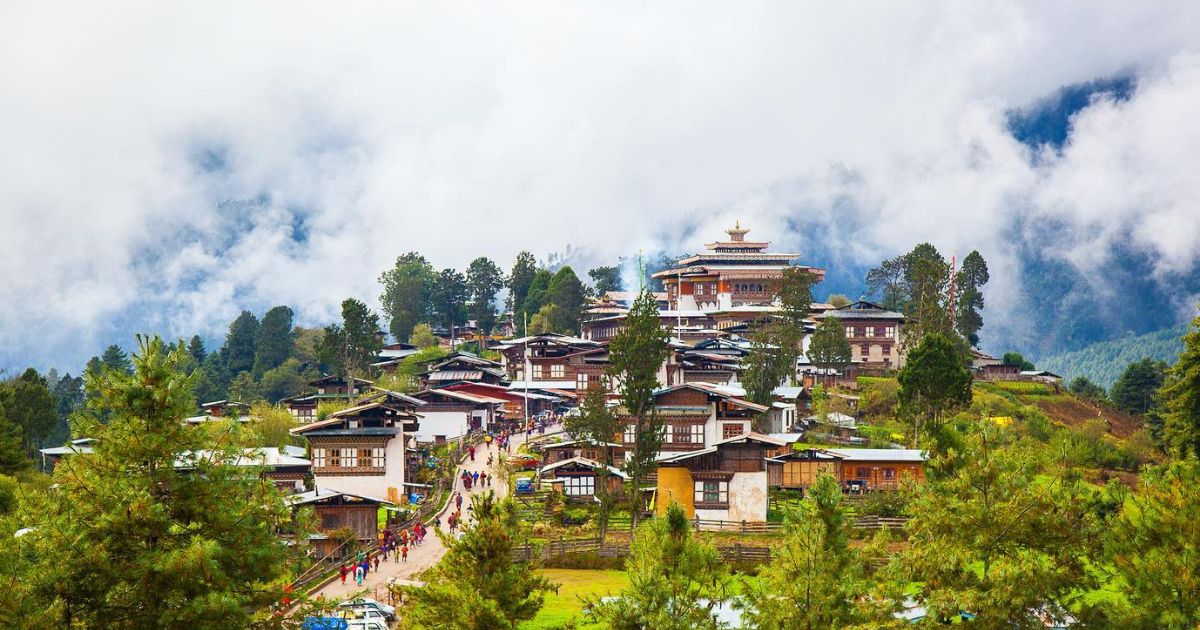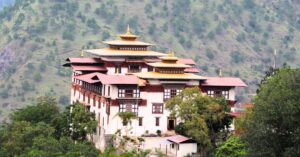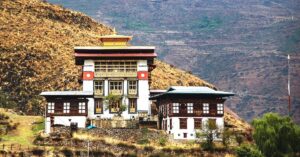Gangtey Monastery, also known as Gangteng Sang Ngag Choling Monastery or Gangtey Goenpa, is a four-story monastery founded by the first Gangteng Tulku, Pema Thinley, a grandson of Terton Pema Lingpa, in 1613. The monastery was built according to Pema Lingpa’s prophecy. It is one of the main centers of Pema Lingpa, situated on a hill in Phobjikha Valley, Wangdue Phodrang Dzongkhag, at an altitude of 3,000 meters.
The Gangtey Goenpa commands striking views of the Phobjikha Valley below, which is home to the Black-Necked Cranes during the winter. Whether you call it the mystique or spiritual sanctity of the monastery, these black-necked cranes circle the monastery three times upon arrival and while departing for Tibet. Therefore, Gangtey monastery is renowned for the Black-necked Crane Festival and the Gangtey Tshechu. So, Gangtey is worth visiting.
Today, Gangteng Goemba is the principal seat of the 9th Gangteng Tulku Kunzang Rigdzin Pema Namgyal. Gangtey Tulku also oversees Kunzangdrak Monastery in Bumthang.
How To Reach Gangtey Monastery
The Gangteng Monastery is situated on a hill in the Gangtey village, overlooking the beautiful Phobjikha Valley. It is located about 66 Kilometers away from Wangduephodrang Dzong and 80 km from Punakha Dzong. Drive on the Wangdue-Trongsa highway and take a short diversion road from Nobding that leads to Gangtey Gonpa. The monastery is open daily from 6:00 AM to 5:00 PM, with a lunch break from 1:00 PM to 2:00 PM. Entry to Gangtey Monastery is free. After visiting the monastery, you can embark on the Gangtey Nature Trail.
Gangtey Nature Trail
Gangtey Nature Trail is a short, popular hike in the Gangtey-Phobjikha Valley. The trail starts at the Mani stone wall and ends at Khewang Lhakhang. This easy hike offers breathtaking views of the U-shaped glacial valley and takes about 90 minutes.
Gangtey Trek
The Gangtey Trek is one of the popular trekking routes in Gangtey, beginning at the base of the Phobjikha Valley, passing through Gangteng Gompa, and continuing through the villages of Kumbu, Gedachen, Khebaythang, Kilkhorthang, and finally ending at Kungathang Lhakhang.
Sacred Relics to See at Gangtey Monastery
- Statue of Guru Nangsi Zilnon;
- Sakyamuni Buddha;
- Funeral Stupa of Tenzing Legpey Dhendup;
- Thongdrol Chhenmo of Sampa Lhundrup;
- Goenkhang of Ma-Za-Dham-Sum and Lhachhen Wangchuk;
- Gonkhang of Pha-Ma-Bhu-Sum and Chhungdu;
- Goenkhang of Mahakala Maning Nagpo;
- Chhagdzoe Lhakhang;
- Tshengye Lhakhang;
- Zimchung Sharim and Nubrim of 2nd Gangteng Trulku;
- Tshepakmed Lhakhang;
- Lamai Lhakhang;
- Machhen Lhakhang;
- Reliquary stupa with remains of the 6th Gangteng Tulku Tenpai Nyima.
History of Gangtey Monastery
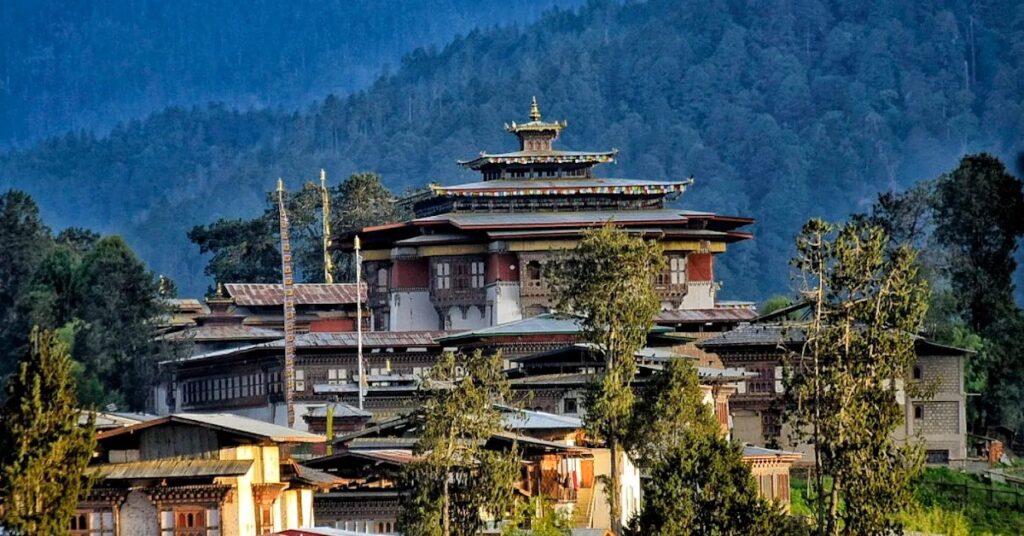
Gangtey Monastery was built by the first Gangteng Trulku, Pema Thinley, in 1613.
According to the history of Gangtey Monastery, Terton Pema Lingpa visited the Phobjikha Valley in the 15th century while he was traveling towards Ngenlung Drechagling to teach Buddhist precepts to the local people. During the visit, after gazing at the impressive hill in the middle of the valley, he prophesied that one of his descendants would build a monastery and establish the seat of the Peling tradition lineage.
According to the prophecy, in 1595, Gyalsey Rigdzin Pema Thinley, the grandson and reincarnation of Terton Pema Lingpa, constructed a one-story temple along with all the required religious relics. Later, in 1613, he built a three-story Lhakhang, which took three years to complete, and named it Gangteng Sang Nga Choling, meaning the “place of secret mantra.”
The construction of Gangtey Lhakhang was undertaken by a team of local craftsmen, led by the zowpon from Lhalung Monastery in Tibet, with the full support of the community. The local materials, such as timber, were sourced from nearby forest trees that were cut, shaped, and used for the construction of the pillars, beams, and windows. A legend has it that the local guardian deity, Delep, helped make building stones available by causing a landslide on the opposite hills.
Subsequently, the second Gangteng Trulku Tenzin Lekpai Dhondrup rebuilt the temple with 12 edges and 18 inner pillars in 1704.
Restoration of Gangtey Goenpa
The 9th Gangteng Trulku, Kunzang Rigzin Pema Namgyal, initiated a major restoration project at Gangteng Monastery in 2002.
During the restoration project, all possible structures, carvings, and paintings were preserved to maintain the original grandeur of the monastery. At the same time, 104 new pillars, intricately crafted by local artisans, were added. The monastery was painted with the locally sourced dotshoen, a durable mineral paint. The ancient path leading to Gangteng was also renovated. The restoration project, which lasted eight years, was completed in 2008, fully restoring the site to its original glory.
Consecration Ceremony
The current and 9th Gangteng Trulku consecrated the Gangteng Sang Ngag Choling Monastery on October 10, 2008.
During the consecration ceremony, hymnal extracts from the original sacred Peling scripture, discovered by Terton Pema Lingpa in southern Tibet, and the Gurdag, dedicated to the wrathful form of Guru Rinpoche, were recited. The annual Gangtey Goenpa Tshechu was held following the consecration ceremony.
Description of Gangtey Monastery
The Gangtey Monastery is located at the heart of sacred sites associated with Guru Rinpoche, with Bumthang Geney Lhakhang to the East, Monyul Namkha Dzong to the South, the famous Paro Taktsang Monastery to the West, and Namthang meditation cave to the North.
Gangtey Monastery is a four-story structure reconstructed in the Tibetan architectural style. Its main hall, the Tshokhang, has a statue of Guru Nangsi Zilnon. The assembly hall is renowned for its eight massive wooden pillars, reputedly the largest in Bhutan, adorned with Jangchub Tungsha Buddhas.
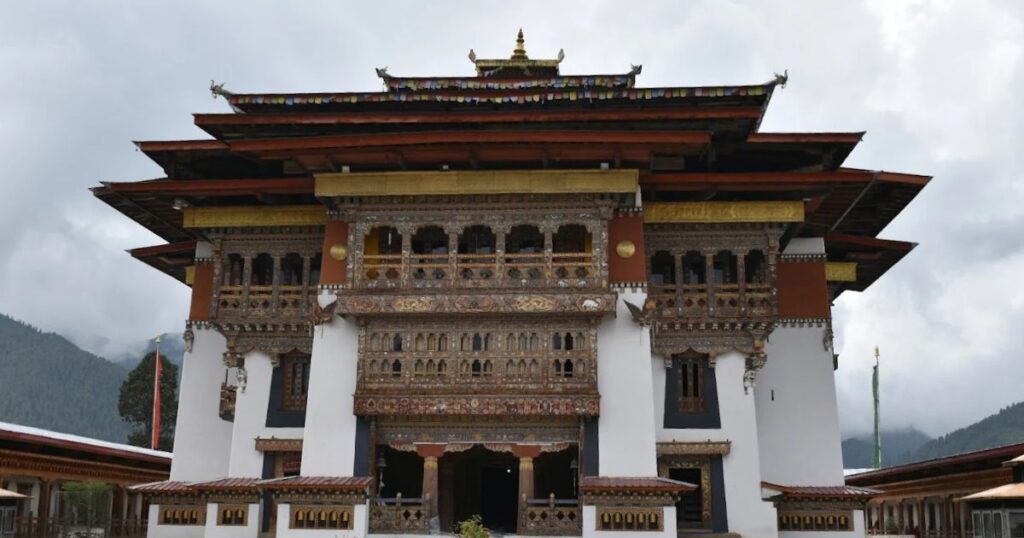
Ground Floor
The ground floor features statues of the 7 Buddhas, with Sakyamuni Buddha at the center, representing the body relic. It also contains the funeral chorten of the second Gangteng Trulku, Tenzin Legpai Dhondup, and the Thongdrol Chhenmo of Sampa Lhundrup as the mind relic.
The wall paintings feature Dorje Phagmo and Pedling Thugje Chhenpo Muensel Droenme on the southern walls, the Gangteng Trulku lineage on the western walls, 21 Taras and Vajra Kila on the eastern walls, and 8 Manifestations of Guru Rinpoche and the Buddha on the northern walls.
First Floor
Eastern Side (Ma-Za-Dham-Sum and Lhachhen Wangchuk Goenkhang)
The Goenkhang of Ma-Za-Dham-Sum and Lhachhen Wangchuk is on the eastern side of the first floor. Originally the sanctum of the speech relic Pedling Chhoekhor, it was later transformed into a protector shrine by Kyabje Rinpoche, who installed Ma-Za-Dham-Sum and Lhachhen Wangchuk.
Western Side (Pha-Ma-Bhu-Sum and Chhungdud Goenkhang)
The Goenkhang of Pha-Ma-Bhu-Sum and Chhungdu, located on the western side, features the main statues of Pha Pehar, Ma Eka Zati, Bhu Damchen Dorje Legpa, as well as the Chhungdu and Pedling Guru Drakpo Yabyum.
Northern Section
The Goenkhang of Mahakala Maning Nagpo, on the right side of the northern section, is guarded by the Kathrabs of Goenpo Maning and Zhingchongma. It houses two pairs of sacred cymbals, discovered by the second Gangteng Tulku from Burning Lake Mebar Tsho and Athang Tsho, as well as another pair from Nub Tsho Na Patra, along with prophetic cymbals brought for sale during a Tshechu.
The Chhagdzoe Lhakhang, located on the left side of the northern part, features a statue of Namsey as the main relic, flanked by Namsey Dungmar and Tsunma Pal Chenmo, along with Noejin Tadhag Gey, Chador, and Tandin.
Second Floor
Tshengey Lhakhang
The south-facing Tshengye Lhakhang houses the main body relic of Guru Pema Jungney, flanked by his two consorts, Yeshe Tshogyal and Mandarava. The speech relics are Nyingmai Gyuebum and Kangyur Chhenmo, while the mind relics are the 8 sandalwood stupas, built by the 2nd Pedthrin. Other statues here are Guru Tshengye, Zhabdrung Rinpoche, and Milarepa.
Zimchung Sharim (Bedroom facing Eastern Mountain) and Nubrim (Bedroom facing Western Mountain)
The Zimchung Sharim and Nubrim are the rooms used by the second Gangteng Trulku for Thoegal meditation. Body relics in these rooms are the 7 Medicinal Buddhas in the Sharim and statues of Pedling Yabsey Sum in the Nubrim.
Tshepakmed Lhakhang
The Tshepakmed Lhakhang, located on the western side, houses a statue of Amitayus in the center, accompanied by a complete set of Pedling Tshethrid Dorje Threngwa as the body relics. Other statues in this temple are the 4 Gods of Life, 7th Pedthrin Ugyen Tenpai Nyingye, Lama Norbu Jamtsho Mandala, and Tsheringma.
Lamai Lhakhang
The Lamai Lhakhang on the eastern side has the golden Dharmakaya Buddha Kuntuzangpo as the main body relic. The mind relics are the Boddhi Stupa of Third Pedthrin Kunzang Thinley Namgyal and an Ethram of ritual daggers, as well as 108 sandalwood daggers. Other statues include the statues of Peling lineage holders and a statue of Zhabdrung Ngawang Namgyal.
Machhen Lhakhang
The Machhen Lhakhang on the northern side houses the Golden Stupa with the remains of the 6th Tulku Tenpai Nyima as the main relic, and a stupa built by the 9th Sungtrul as the mind relic. Other statues include 16 Arhats, 8th Pedthrin Thinley Dorje, Kunkhen Longchhen, Zhingkyong Wangmo, Guru Padma Sambhava, and 9th Sungtrul Tenzin Choeki Gyaltshen.
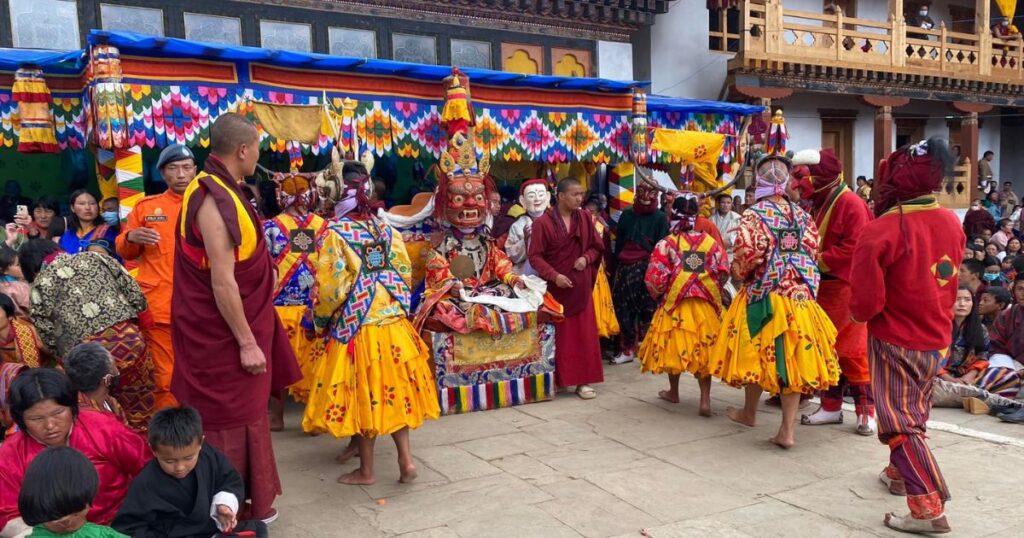
Gangtey Monastery Festival
Gangtey Tshechu Festival
The Gangtey Tshechu is a 3-day annual festival held in the courtyard of Gangtey Monastery from the 13th to 15th day of the 8th month of the Bhutanese calendar. The Gangtey Tshechu features various mask dances and traditional performances, culminating in the unfurling of the Guru Thongdrol.
The Black Necked Crane Festival
The Black-necked Crane Festival is a celebration to mark the arrival of Black-necked Cranes from Tibet to Phobjikha Valley during the winter months. It is held annually on 11 November in the courtyard of Gangtey Monastery. The black-necked cranes are said to circumambulate the Gangteng monastery three times before settling in the Phobjikha Valley, and then flying back to Tibet.
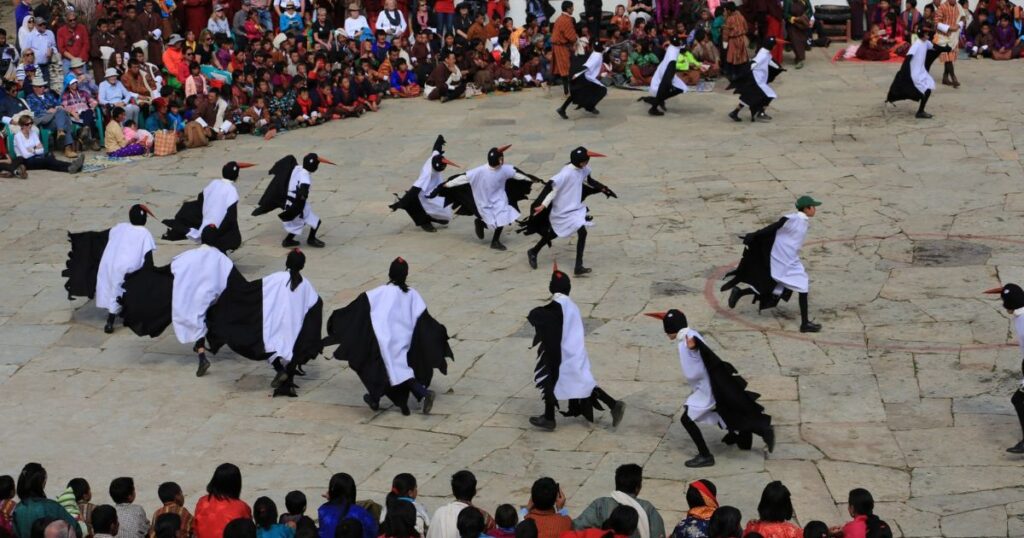
Best Time to Visit Gangtey Monastery
The best months to visit Gangtey Valley are March to May (Spring) and September to November (Autumn). If you love participating in local festivals, consider planning your trip for either the Black-necked Crane Festival or the Gangtey Tshechu. However, late October to mid-February is the best time to see black-necked cranes. You can visit the major pilgrimage sites of Wangdue Phodrang with the Bhutan Pilgrimage Package.
Conclusion
Gangtey Monastery, also known as Gangteng Goenpa, was founded by Gyalse Pema Thinley, the first Gangteng Trulku, in 1613. Its location on a hill in the Phobjikha Valley offers not only a place of worship but also a panoramic vantage point over a rich natural landscape.
Enjoyed reading this blog?

